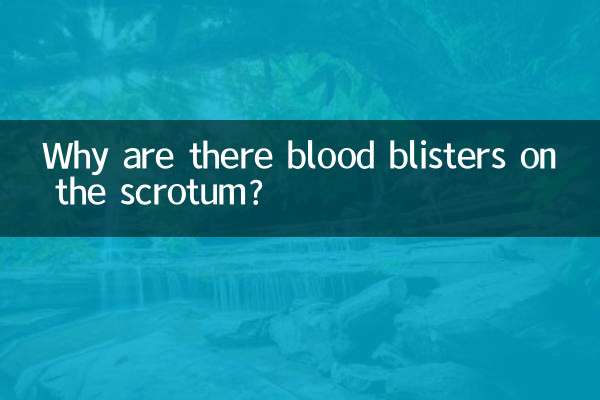What is happening with liver nodules?
In recent years, with the popularization of health examinations and the advancement of imaging technology, more and more people are discovering liver nodules during physical examinations. What exactly is happening with liver nodules? Is it benign or malignant? What needs to be done? This article will give you a detailed explanation based on the hot topics and hot content on the Internet in the past 10 days.
1. Definition and common types of liver nodules

Liver nodules refer to local abnormal growths or masses that appear in liver tissue, with varying sizes, shapes and properties. According to pathological properties, liver nodules can be divided into two categories: benign and malignant.
| Type | common diseases | Features |
|---|---|---|
| benign nodules | Hepatic hemangioma, liver cyst, focal nodular hyperplasia (FNH), hepatic adenoma | Slow-growing, well-defined, usually does not require special treatment |
| malignant nodule | Liver cancer (primary or metastatic), cholangiocarcinoma | Fast growth, blurred borders, may be accompanied by other symptoms |
2. Common causes of liver nodules
The formation of liver nodules is related to many factors. The following are the causative factors that have been highly searched in the past 10 days:
| Reason | Description | Hot search index (last 10 days) |
|---|---|---|
| viral infection | Viral infections such as hepatitis B and hepatitis C may lead to cirrhosis and even liver cancer | ★★★★★ |
| alcohol abuse | Long-term heavy drinking can cause alcoholic liver disease and increase the risk of nodules | ★★★★☆ |
| Metabolic abnormalities | Metabolic diseases such as non-alcoholic fatty liver disease and diabetes | ★★★☆☆ |
| genetic factors | Certain genetic diseases such as hemochromatosis, Wilson's disease, etc. | ★★☆☆☆ |
| drugs or toxins | Long-term use of certain medications or exposure to toxic substances | ★★☆☆☆ |
3. Common symptoms of liver nodules
Most liver nodules have no obvious symptoms in the early stage, especially benign nodules. However, when the nodule enlarges or becomes a malignant tumor, the following symptoms may occur:
1.Discomfort or pain in the right upper quadrant: This is the related symptom with the highest search volume in the past 10 days
2. Unexplained weight loss
3. Loss of appetite, nausea and vomiting
4. Yellowing of the skin and eyes (jaundice)
5. Abdominal swelling or ascites
6. Weakness and easy fatigue
4. Diagnostic methods of liver nodules
Based on the hot medical topics in the past 10 days, the following are commonly used clinical diagnostic methods:
| Check method | Advantages | limitations |
|---|---|---|
| Ultrasound examination | Non-invasive, convenient and low price | Limited resolution for small nodules |
| CT scan | High resolution allows assessment of blood flow | There is radiation and contrast agent injection is required |
| MRI examination | No radiation, good soft tissue contrast | High price, long inspection time |
| blood test | Test liver function and tumor markers | Not very specific |
| liver biopsy | gold standard for diagnosis | Invasive examination carries risks |
5. Treatment strategies for liver nodules
The treatment plan needs to be comprehensively determined based on the nature, size, location of the nodule and the patient’s overall condition:
1.benign nodules: Most do not require treatment and regular follow-up is enough. For larger hemangiomas or those with symptoms, intervention or surgery may be considered.
2.malignant nodules:
- Surgical resection: suitable for early liver cancer
- Liver transplant: considered under certain conditions
- Local ablation: radio frequency, microwave, etc.
-Interventional treatment: TACE (transcatheter arterial chemoembolization)
- Targeted therapy and immunotherapy: options for advanced liver cancer
6. Prevention and daily precautions
Based on recent health hot spots, it is recommended to take the following preventive measures:
1. Get vaccinated against hepatitis B to prevent viral infection
2. Limit alcohol intake. It is recommended that no more than 25g per day for men and 15g for women.
3. Maintain a healthy weight and control the risk of fatty liver disease
4. Avoid abusing drugs and health supplements
5. Regular physical examinations, especially for those with risk factors for liver disease
6. After discovering nodules, follow the doctor’s instructions for regular check-ups, and don’t panic too much.
7. Answers to recent hot issues
According to the hot Internet searches in the past 10 days:
Q: Will liver nodules found in physical examination definitely become cancerous?
A: No. Most liver nodules are benign, and according to statistics, about 70% of liver nodules are benign lesions.
Q: Does liver hemangioma need treatment?
A: Most small hepatic hemangiomas do not require treatment and require regular observation. Treatment should only be considered if the hemangioma is large (usually >5 cm) or symptomatic.
Q: What department should I go to if liver nodules are found?
A: It is recommended to first consult a gastroenterology department or hepatobiliary surgery department. Depending on the examination results, you may need to be transferred to an oncology department.
In short, the causes of liver nodules are complex and diverse. There is no need to panic after discovery, but neither should we take it lightly. It is recommended to seek medical treatment promptly, clarify the nature through professional examination, and formulate a reasonable follow-up or treatment plan. Maintaining good living habits and regular physical examinations are the best strategies for preventing liver disease.

check the details

check the details